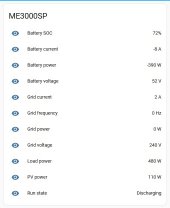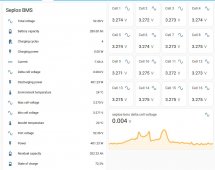Hi all
I am currently looking at fitting an AC coupled storage inverter, something like a Sofar ME3000SP and programming it to charge on off peak electricity on Octopus GO @ 7.5p per kWh and using it to charge a big bank of prismatic lithium cells or LG Chem cells in a home made storage rack.
The web is littered with salvage EV packs that are significantly cheaper per kW than the likes of Pylontech server rack packs etc.
The problem is that all of the grid tied inverters seem to be tied to either their own manufacturers battery packs which are circa £5k for 10kW of storage or will only work with off the shelf packs that are equally pricy.
Is there a grid tied inverter solution out there that will work with an off the shelf BMS that enables you to build your own storage pack?
I would like to build a 30kW pack that chargers nightly and supplies 90% of my power demands but is grid tied so when my power demand exceeds the inverters output capacity it imports from the grid to supplement the load requirements.
Is this possible, and if so what kit would I need to do this with?
I am currently looking at fitting an AC coupled storage inverter, something like a Sofar ME3000SP and programming it to charge on off peak electricity on Octopus GO @ 7.5p per kWh and using it to charge a big bank of prismatic lithium cells or LG Chem cells in a home made storage rack.
The web is littered with salvage EV packs that are significantly cheaper per kW than the likes of Pylontech server rack packs etc.
The problem is that all of the grid tied inverters seem to be tied to either their own manufacturers battery packs which are circa £5k for 10kW of storage or will only work with off the shelf packs that are equally pricy.
Is there a grid tied inverter solution out there that will work with an off the shelf BMS that enables you to build your own storage pack?
I would like to build a 30kW pack that chargers nightly and supplies 90% of my power demands but is grid tied so when my power demand exceeds the inverters output capacity it imports from the grid to supplement the load requirements.
Is this possible, and if so what kit would I need to do this with?





